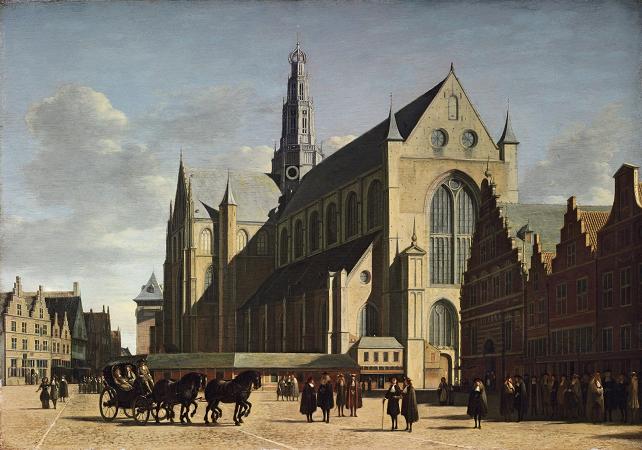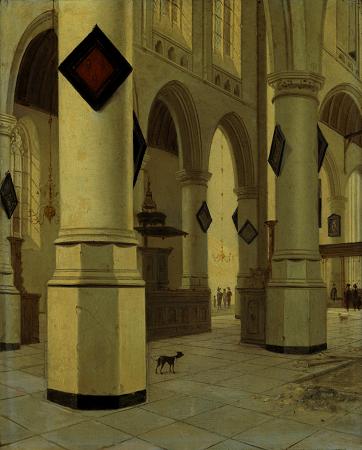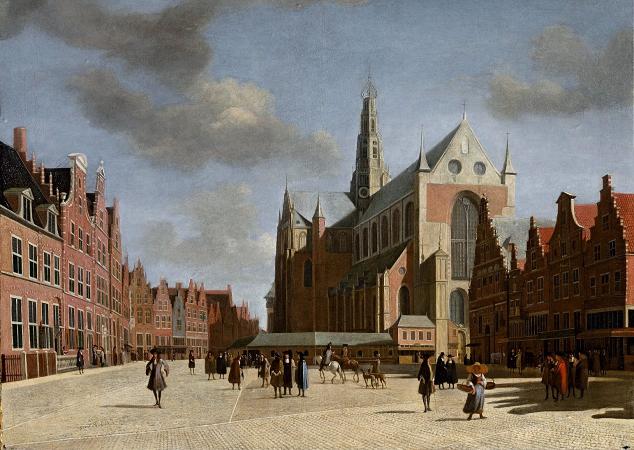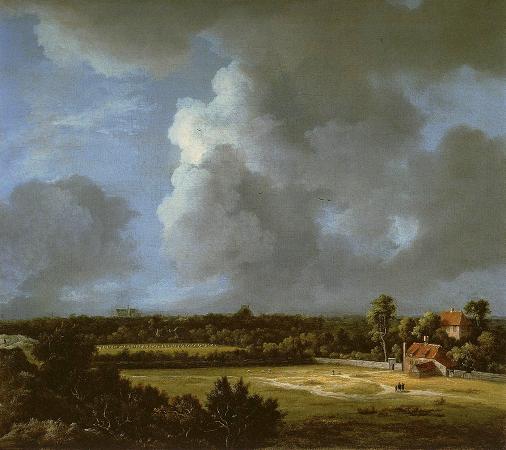Grote Kerk, Haarlem. The Grote Kerk or St.-Bavokerk is a Reformed Protestant church and former Catholic cathedral located on the central market square in the Dutch city of Haarlem. Another Haarlem church called the Cathedral of Saint Bavo now serves as the main cathedral for the Roman Catholic Diocese of Haarlem-Amsterdam. This church is an important landmark for the city of Haarlem and has dominated the city skyline for centuries. It is built in the Gothic style of architecture, and it became the main church of Haarlem after renovations in the 15th century made it significantly larger than the Janskerk. First mention of a church on this spot was made in 1307, but the wooden structure burned in the 14th century. The church was rebuilt and promoted to chapter church in 1479 and only became a cathedral in 1559. The main architects were Godevaert de Bosscher and Steven van Afflighem, and Evert van Antwerpen. The term Catholic was never really associated with this church, since it was only consecrated as a cathedral in 1559, which was already in the middle of the period known as the Protestant Reformation. The church was confiscated only 19 years later during the Haarlemse noon in 1578, when it was converted to Protestantism. It was dedicated to Saint Bavo at some time before 1500, though there exists a curious painting in the collection of the Catholic Cathedral of St. Bavo illustrating the miracle of St. Bavo saving Haarlem from the Kennemers in a scene from the 13th century. This painting was painted a century after the Catholics were banned from their church, and may have been a commemorative painting referring to the defense of the Church and the Catholic faith as well as the defense of the city. Haarlem has had a Christian parish church since the 9th century. This first church was a daughter church of Velsen, which itself was founded in 695 by St. Willibrord. This early first church was a wooden church on the same site of the current Sint-Bavokerk. Extensions and expansions over the centuries led to its formal consecration in 1559 when the first bishop Nicolaas van Nieuwland was appointed. Only 19 years later, after the Spanish occupation ended and Haarlem reverted to the Protestant House of Orange, the church was confiscated during the episode known as the Haarlemse noon and converted to Protestantism as part of the Protestant Reformation. At this time most of the art and silver artefacts were also seized and what was not sold or destroyed has survived in the Haarlem municipal collection, which is now in the collection of the Frans Hals Museum. The Haarlem Catholics took what they could carry with them and went underground, meeting thereafter in various schuilkerken, the most prominent ones known as the St. Franciscus statie and the St. Josephs statie. Eventually, the St. Josephstatie built a new church across from the Janskerk called the St. Josephkerk, and this church, after growing and becoming a cathedral again, built a new cathedral on the Leidsevaart in the 19th century. Since the building of this new Cathedral of St. Bavo, there has been lots of confusion about the name of the Bavochurch, since as a Protestant church it is not even dedicated to Saint Bavo. For this reason it is officially called Grote Kerk, which just means Big Church. On May 22, 1801 there was a fire caused by lightning which struck the tower. Another disaster was prevented in 1839 by Martijn Hendrik Kretschman, the guard of the tower. He stopped Jan Drost who worked for the church. Drost had tried to set fire to the pipe organ and piano by throwing hot coals on top of it. Drost committed suicide and he was buried in the tower. In the church was a high sentry box reserved for fire-watchers. If they saw a fire in the city then they would signal using red flags so that the guards in the main guard house opposite could react. This sentry position was still in use in 1919. In the renovation of the 1930s an automatic sprinkler system was installed in the tower, that could extinguish a fire 70m high in the tower. Though the exterior of the church seems timeless, it changed twice in the past 500 years; once when all statuary was removed from the outer niches during the Haarlemse Noon, and the second time in the late 19th century when a more Gothic look was given to the church by adding some fake ramparts to the roof edge. This can be seen easily when comparing pictures made before and afterwards. Around the church various low buildings have been built up against it, most notably the former fish market called De Vishal, which today is used for exhibiting modern art.
more...











